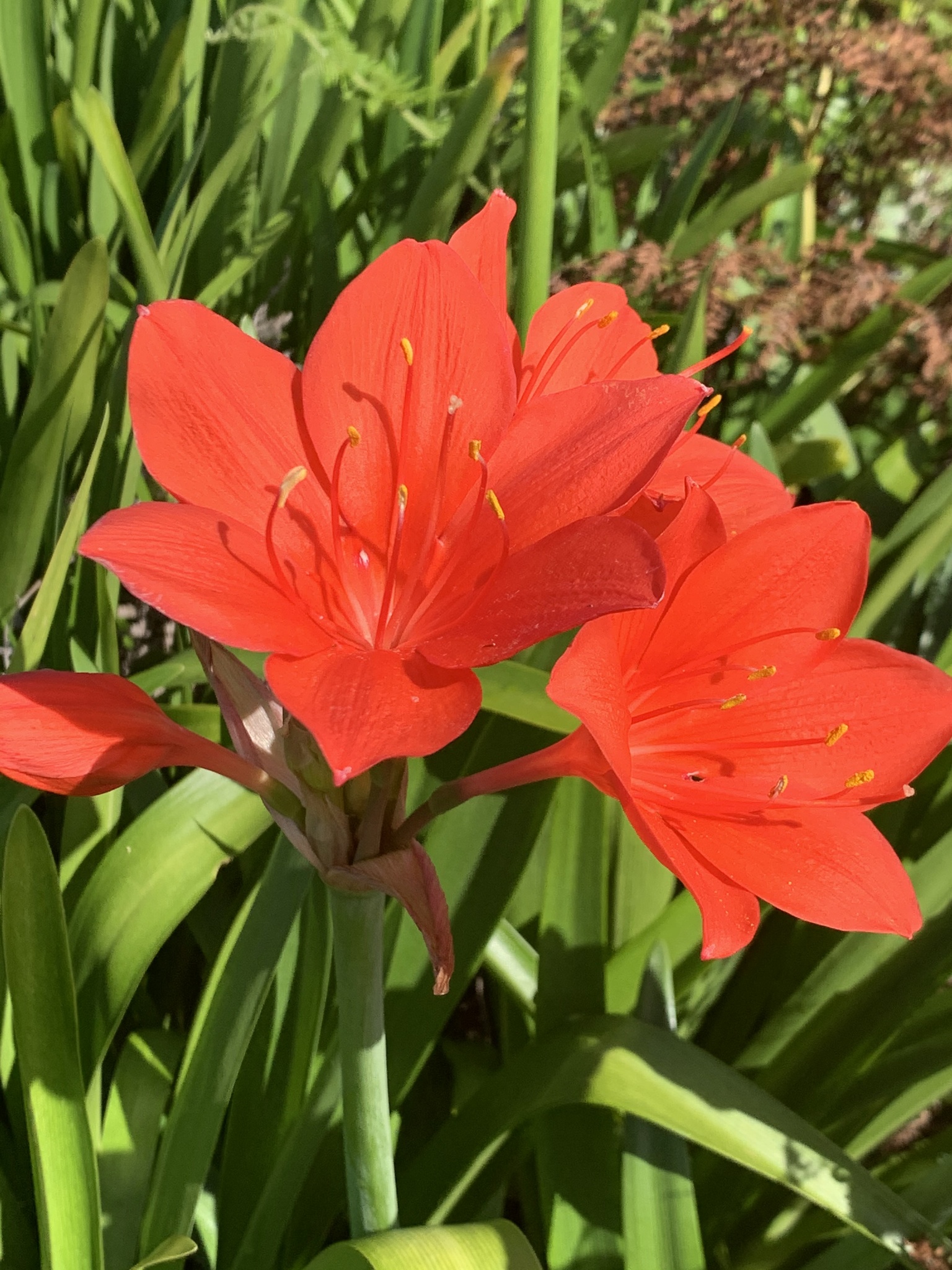Key Takeaways
- Scarborough Lily, also known as Cyrtanthus elatus, is a bulbous plant native to South Africa, recognized for its striking red, trumpet-shaped flowers.
- These lilies require well-draining soil and moderate watering, making them suitable for both indoor and outdoor environments.
- Scarborough Lilies are toxic to pets, particularly cats and dogs, and should be kept out of their reach to prevent any harmful effects.
- They thrive best in bright, indirect sunlight and can be propagated by separating mature tubers with attached roots.
- Comparatively, Scarborough Lilies are less fragrant than other lilies but offer a longer blooming period with proper care.
Captivating Beauty of Scarborough Lily
The Scarborough Lily, or Cyrtanthus elatus, is a plant that captivates with its vibrant, fiery red blooms. These flowers are not just beautiful; they are a testament to nature’s resilience and adaptability. Originating from the southern regions of Africa, the Scarborough Lily has made its way into homes and gardens around the world, celebrated for its ornamental appeal.
What makes this lily particularly special is its ability to thrive in both indoor and outdoor settings. Its adaptability to various climates, coupled with its striking appearance, makes it a favorite among gardening enthusiasts. But to truly appreciate and care for this plant, one must first understand its unique characteristics and requirements.
- Native habitat: Southern Africa
- Bloom color: Vibrant red
- Ideal growing conditions: Well-draining soil, moderate watering
- Common names: George firelily, Fire lily, Jersey lily
“Photos of Scarborough lily (Cyrtanthus …” from www.inaturalist.org and used with no modifications.
Identifying Scarborough Lily
Identifying a Scarborough Lily is relatively straightforward due to its distinctive features. The plant boasts long, slender leaves that arch gracefully, creating an elegant silhouette. Its flowers, which resemble trumpets, burst forth in shades of bright red, making them easily recognizable. These blooms typically appear in clusters, adding a splash of color to any garden or room.
Recognizing the Vibrant Blooms
The blooms of the Scarborough Lily are not only vibrant but also long-lasting. They typically appear in late summer to early autumn, providing a visual treat when many other plants have ceased flowering. The flowers are tubular, with a slightly flared end, and can measure up to three inches in length. This unique shape, combined with their vivid color, makes them a standout feature in any floral arrangement.
Comparison with Other Lilies
While the Scarborough Lily shares some similarities with other members of the lily family, it has distinct differences that set it apart. Unlike the heavily scented Asiatic or Oriental lilies, the Scarborough Lily is relatively unscented, making it ideal for those who prefer less fragrant blooms. Additionally, it tends to have a longer blooming period, providing color and interest over several weeks.
Here’s a quick comparison between Scarborough Lilies and other common lilies:
Lily Type | Fragrance | Bloom Period | Color Variations |
|---|---|---|---|
Scarborough Lily | Mild | Late summer to early autumn | Primarily red |
Asiatic Lily | None | Early to mid-summer | Wide range |
Oriental Lily | Strong | Mid to late summer | White, pink, yellow |
Scarborough Lily Care Essentials
Caring for a Scarborough Lily requires understanding its specific needs. This plant is relatively low-maintenance, but attention to detail can significantly enhance its growth and blooming potential. Let’s dive into the essential care practices for this stunning lily.
Optimal Watering Practices
Watering is crucial for the Scarborough Lily’s health. The key is to maintain balanced moisture levels without overwatering. Typically, watering every 1-2 weeks is sufficient, allowing the soil to dry slightly between waterings. This plant stores water in its bulbs, which helps it tolerate short periods of dryness. However, consistent overwatering can lead to bulb rot, a common issue for many bulbous plants.
Sunlight and Soil Requirements
Scarborough Lilies thrive in bright, indirect sunlight. While they can tolerate direct sun for short periods, prolonged exposure can scorch their leaves. Therefore, a location that offers morning sun and afternoon shade is ideal. As for soil, well-draining varieties are essential to prevent waterlogging. A mix of sand, peat, and perlite can create the perfect environment for these lilies to flourish.
In the next part, we’ll explore nourishment and fertilization, how to prevent common diseases, and more tips to ensure your Scarborough Lily thrives. For those interested in a broader perspective on pet care, check out this guide to smart home devices for pet care.
Nourishment and Fertilization
Feeding your Scarborough Lily is a straightforward process that significantly enhances its growth and bloom quality. These lilies benefit from a balanced, water-soluble fertilizer applied every four to six weeks during the growing season, typically from spring to early autumn. Look for a fertilizer with an equal ratio of nitrogen, phosphorus, and potassium, such as a 10-10-10 blend.
When applying fertilizer, ensure that the soil is already moist to prevent root burn. Dilute the fertilizer to half the recommended strength to avoid over-fertilizing, which can lead to lush foliage but fewer flowers. Always follow the manufacturer’s instructions to achieve the best results.
Preventing Common Diseases
Scarborough Lilies are generally robust plants, but they can fall victim to common diseases if not properly cared for. Fungal infections such as botrytis blight can occur in overly damp conditions. To prevent this, ensure good air circulation around the plant and avoid wetting the leaves when watering. If you notice any signs of disease, such as discolored spots on leaves or flowers, treat the plant with a fungicide promptly.
Pests like aphids and spider mites can also pose a threat. Regularly inspect your plants for any signs of infestation, and if detected, use insecticidal soap or neem oil as an organic solution. Maintaining a clean growing environment and removing dead plant material can also reduce the risk of pest and disease issues. For more tips on creating a safe environment for your plants and pets, check out this pet-friendly furniture guide.
Flower Production and Maintenance
Achieving a prolific bloom with your Scarborough Lily requires attention to detail and a bit of patience. The key is to create conditions that mimic their natural habitat as closely as possible. This includes providing ample light, maintaining consistent moisture levels, and feeding them regularly.
In addition to these basics, deadheading spent flowers can encourage the plant to produce more blooms. By removing faded flowers, you prevent the plant from expending energy on seed production, redirecting it instead toward new growth and flowering. For those interested in pet socialization, understanding plant care can be a complementary skill in creating a harmonious environment.
Enhancing Blooms Throughout the Year
While the Scarborough Lily’s primary blooming period is late summer to early autumn, you can extend its flowering season with a few strategic steps. One effective method is to stagger planting times. By planting bulbs at intervals of a few weeks, you can enjoy a succession of blooms over a longer period. For more detailed information on the Scarborough Lily, visit NC State Extension.
Additionally, maintaining optimal growing conditions year-round is crucial. This includes providing adequate light and consistent watering, as well as ensuring the plant is free from stressors such as pests or disease. A healthy plant is more likely to produce abundant and long-lasting blooms.
Pruning for Aesthetic Appeal and Health
Pruning is an essential part of maintaining the health and appearance of your Scarborough Lily. Start by removing any dead or damaged leaves, as well as spent flower stalks. This not only keeps the plant looking tidy but also improves air circulation and reduces the risk of disease.
Regular pruning encourages the plant to focus its energy on new growth and flower production. Be sure to use clean, sharp tools to make precise cuts, minimizing the risk of infection. Remember, the goal of pruning is not just to enhance the plant’s appearance but also to promote its overall vitality. For more information on the Scarborough Lily, visit this detailed guide.
Displaying in Vases and Indoor Spaces
Scarborough Lilies make excellent cut flowers, adding a touch of elegance to any indoor setting. Their vibrant red blooms can brighten up a room and serve as a striking focal point in floral arrangements. When cutting lilies for indoor display, select flowers that are just beginning to open for the longest vase life. For more tips on maintaining a pet-friendly home, consider exploring smart home devices for pet care.
To prepare the flowers for a vase, remove any leaves that would be submerged in water to prevent decay. Cut the stems at a 45-degree angle under running water to improve water uptake, and place them in a clean vase filled with fresh water. For those who may find it challenging to maintain plants, there are solutions for seniors unable to care for pets that might be helpful.
Preparing Scarborough Lily for Vase Arrangements
To ensure your Scarborough Lily looks its best in a vase, consider pairing it with complementary flowers and greenery. Its bold red color pairs well with whites and greens, creating a classic and timeless look. You can also add elements like baby’s breath or ferns for added texture and contrast. For pet owners, it’s important to choose pet-friendly arrangements that ensure the safety of your furry friends.
Change the water every few days and trim the stems slightly to maintain freshness. Keep the arrangement out of direct sunlight and away from heat sources to prolong the life of the flowers.
Ensuring Longevity in Indoor Display
To maximize the lifespan of your Scarborough Lily in a vase, follow a few simple tips. First, keep the arrangement in a cool area, as heat can accelerate wilting. Additionally, avoid placing the vase near ripening fruit, as the ethylene gas released can shorten the life of the flowers. For more tips on maintaining a pet-friendly home environment, check out this pet-friendly furniture guide.
Finally, adding a floral preservative to the water can help keep the blooms fresh for longer. These preservatives contain nutrients and antibacterial agents that support the flowers’ health and prevent the growth of harmful bacteria. For more information on plant care, you can visit the NC State Extension website.
Safety for Pets and Allergy Concerns
When it comes to the safety of our furry friends, the Scarborough Lily requires careful consideration. This beautiful plant, while a delight to the eyes, poses significant risks to pets, especially cats and dogs. Understanding these risks is crucial for any pet owner who also loves gardening.
The primary concern with Scarborough Lily is its toxicity. All parts of the plant, including the bulbs, leaves, and flowers, contain compounds that can be harmful if ingested by pets. Symptoms of poisoning can range from mild stomach upset to more severe issues such as vomiting, diarrhea, and lethargy. For more detailed information on the plant, you can visit the PictureThis guide on Cyrtanthus elatus.
- Symptoms of poisoning: Vomiting, diarrhea, lethargy
- Most at risk: Cats and dogs
- Precaution: Keep plants out of reach of pets
To protect your pets, it is best to keep Scarborough Lilies out of reach. Consider placing them in elevated areas or using protective barriers if you have curious animals. Educating yourself and your family about the risks can also prevent accidental exposure.
Besides direct contact with the plant, be mindful of fallen leaves or petals that might be accessible to pets. Regularly clean the area around your plants to minimize risk.
Understanding the Toxicity of Scarborough Lily
Scarborough Lily contains alkaloids, which are the primary toxic agents. These substances interfere with the normal functioning of the digestive and nervous systems in animals. Even small amounts can cause adverse reactions, making it essential to act quickly if ingestion occurs.
Common Allergic Reactions and Precautions
In addition to being toxic to pets, Scarborough Lily can also cause allergic reactions in some people. Common symptoms include skin irritation, itching, or respiratory discomfort when handling the plant or being in close proximity to it. Wearing gloves and long sleeves while gardening can help prevent skin contact.
ASPCA vs Others on Toxicity
The American Society for the Prevention of Cruelty to Animals (ASPCA) categorizes Scarborough Lily as toxic to pets. Other organizations, including veterinary groups, echo this sentiment, emphasizing the need for caution. While the severity of symptoms can vary, the consensus is clear: Scarborough Lily is not pet-friendly.
“Scarborough Lily is considered toxic to cats, dogs, and even horses. Pet owners should take steps to ensure these plants are kept away from animals.” — ASPCA
For those who love both plants and pets, choosing non-toxic alternatives might be a safer option. Always consult your veterinarian if you suspect your pet has ingested any part of a potentially harmful plant.
Frequently Asked Questions
To wrap up, here are answers to some common questions about Scarborough Lilies, helping you to care for them more effectively and safely.
Are Scarborough Lilies Safe around Cats and Dogs?
No, Scarborough Lilies are not safe around cats and dogs. They contain toxic compounds that can cause serious health issues if ingested. It’s best to keep them out of reach or choose non-toxic plants if you have pets at home.
How Can I Propagate Scarborough Lily?
To propagate Scarborough Lily, carefully separate mature tubers with roots attached. Plant them in well-draining soil, ensuring they are spaced adequately to allow for growth. Water them regularly, but avoid overwatering to prevent rot.
Propagation is best done during the plant’s dormant period, usually in late autumn or early winter. This allows the new plants to establish roots before the growing season begins.
Patience is key when propagating Scarborough Lilies. It may take a few seasons before the new plants produce flowers, but the wait is well worth it for their stunning blooms.
What Are the Common Pests for Scarborough Lily?
Scarborough Lilies can fall victim to several common pests, including aphids, spider mites, and mealybugs. These pests can damage the plant by sucking sap, leading to wilting and reduced vigor.
To manage pests, regularly inspect your plants and remove any visible insects by hand or with a gentle spray of water. For more severe infestations, consider using insecticidal soap or neem oil, which are effective yet safe for the environment.






